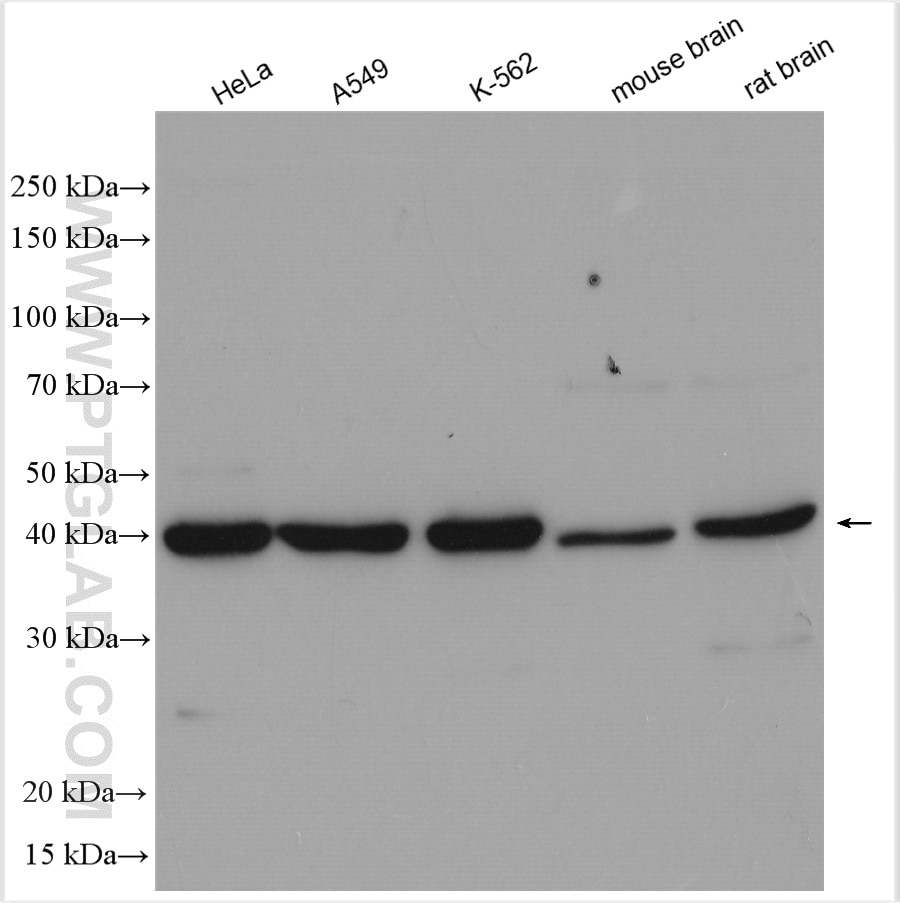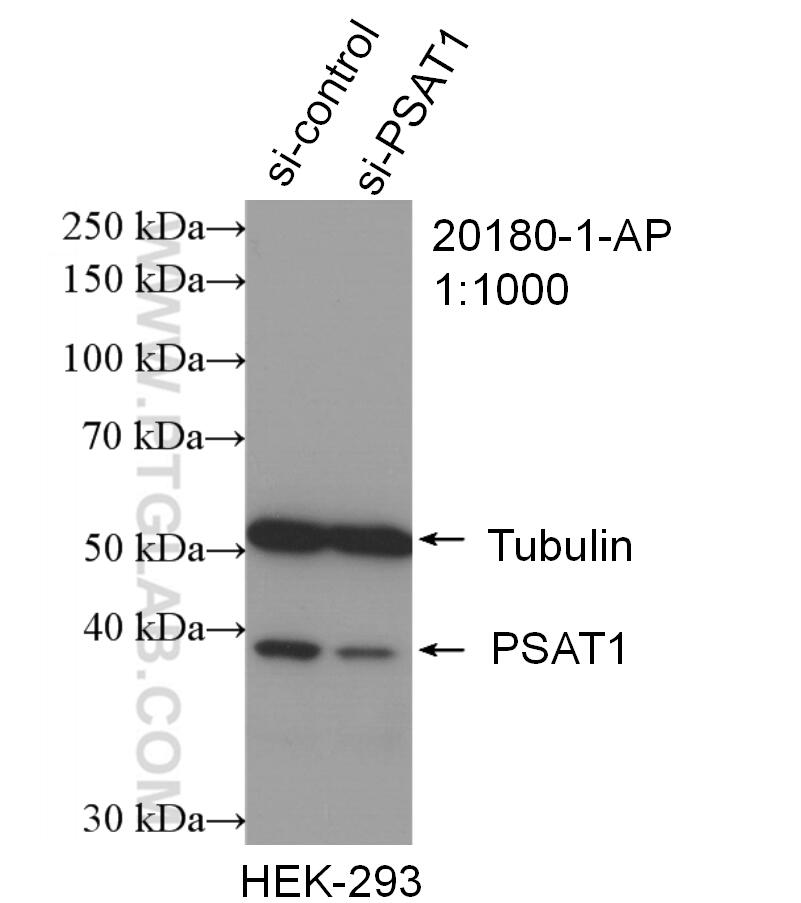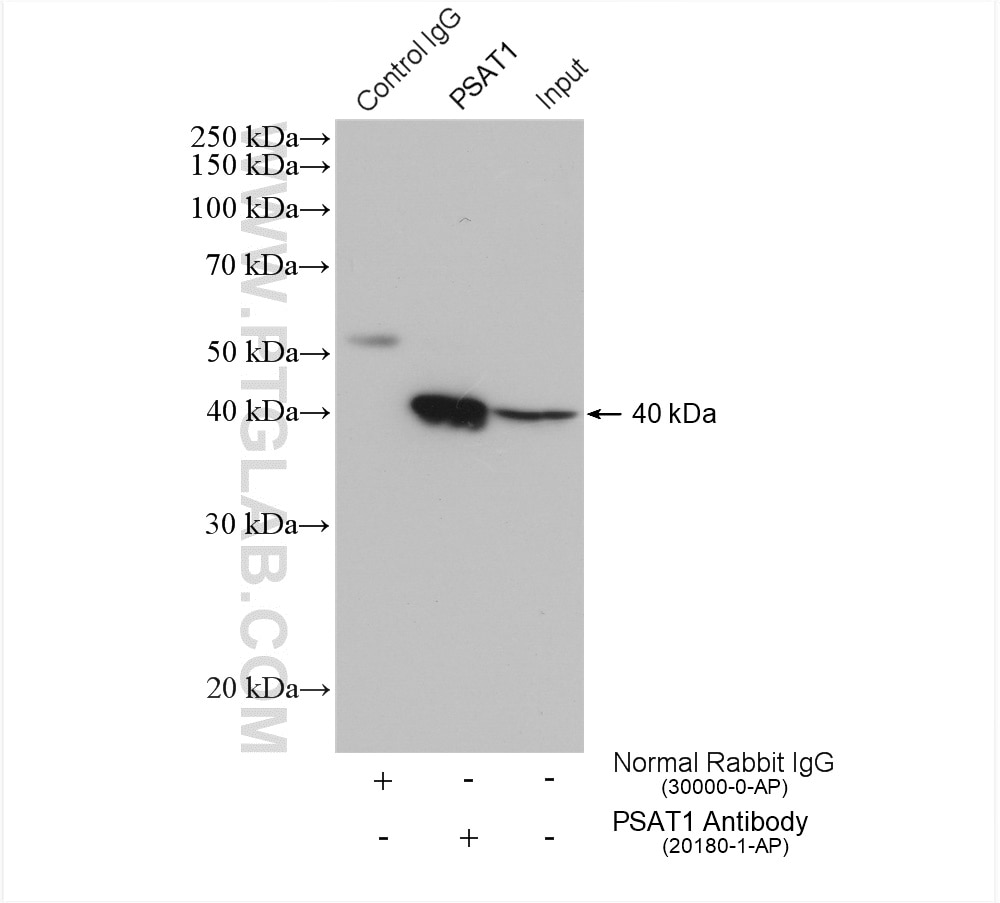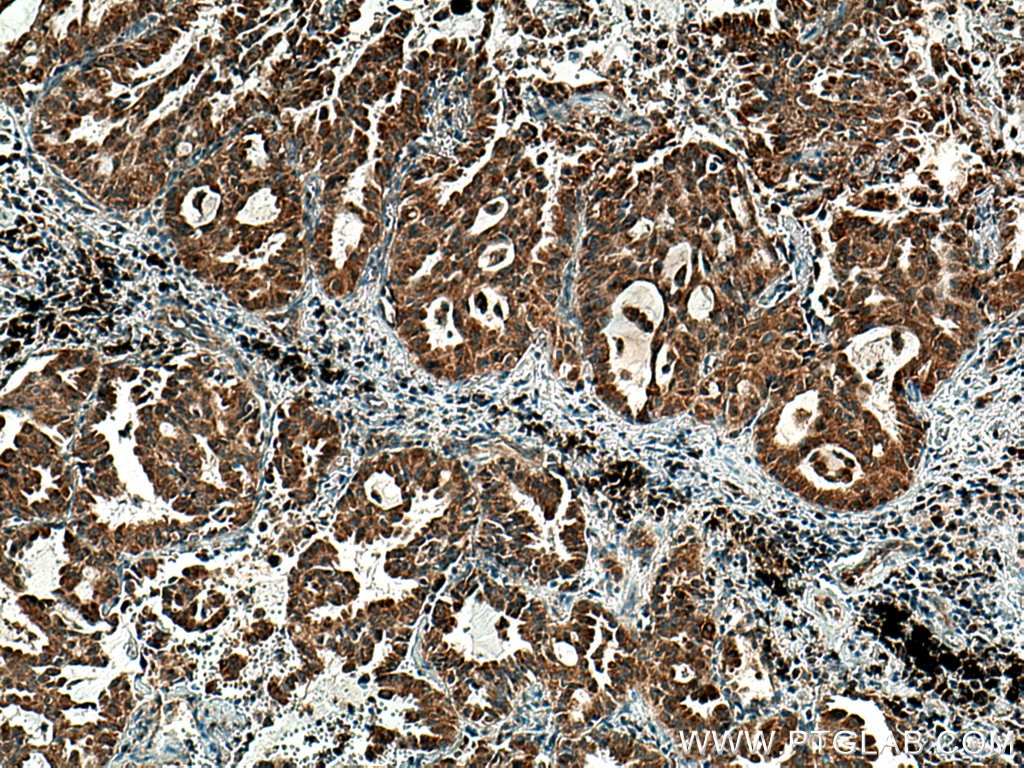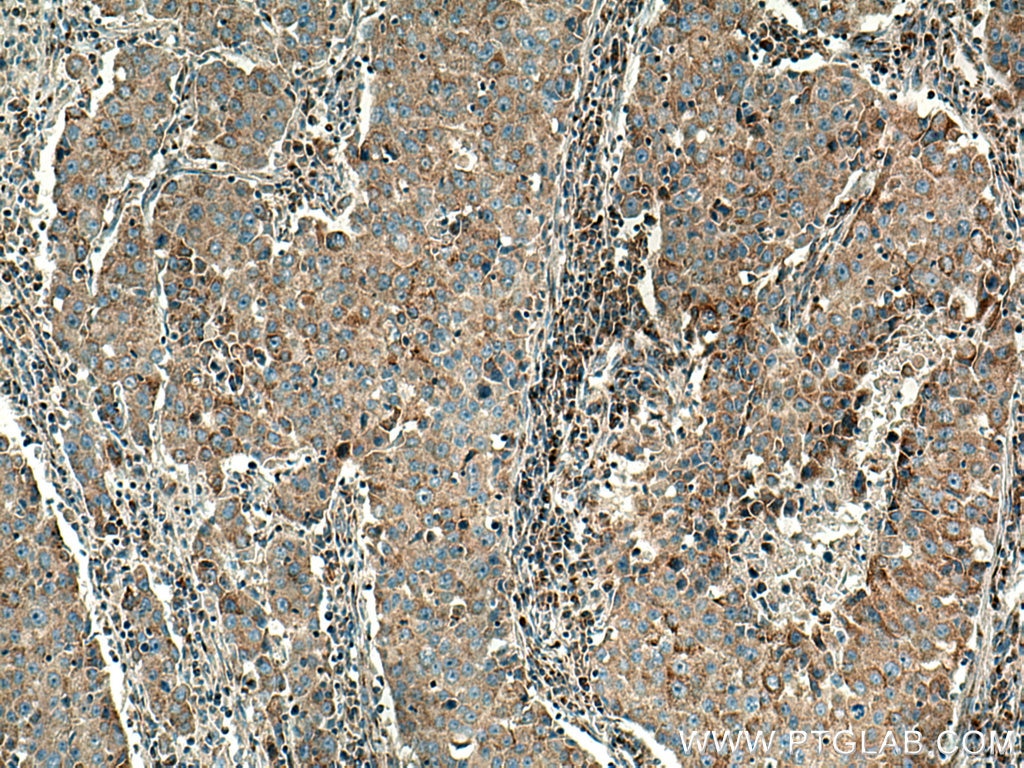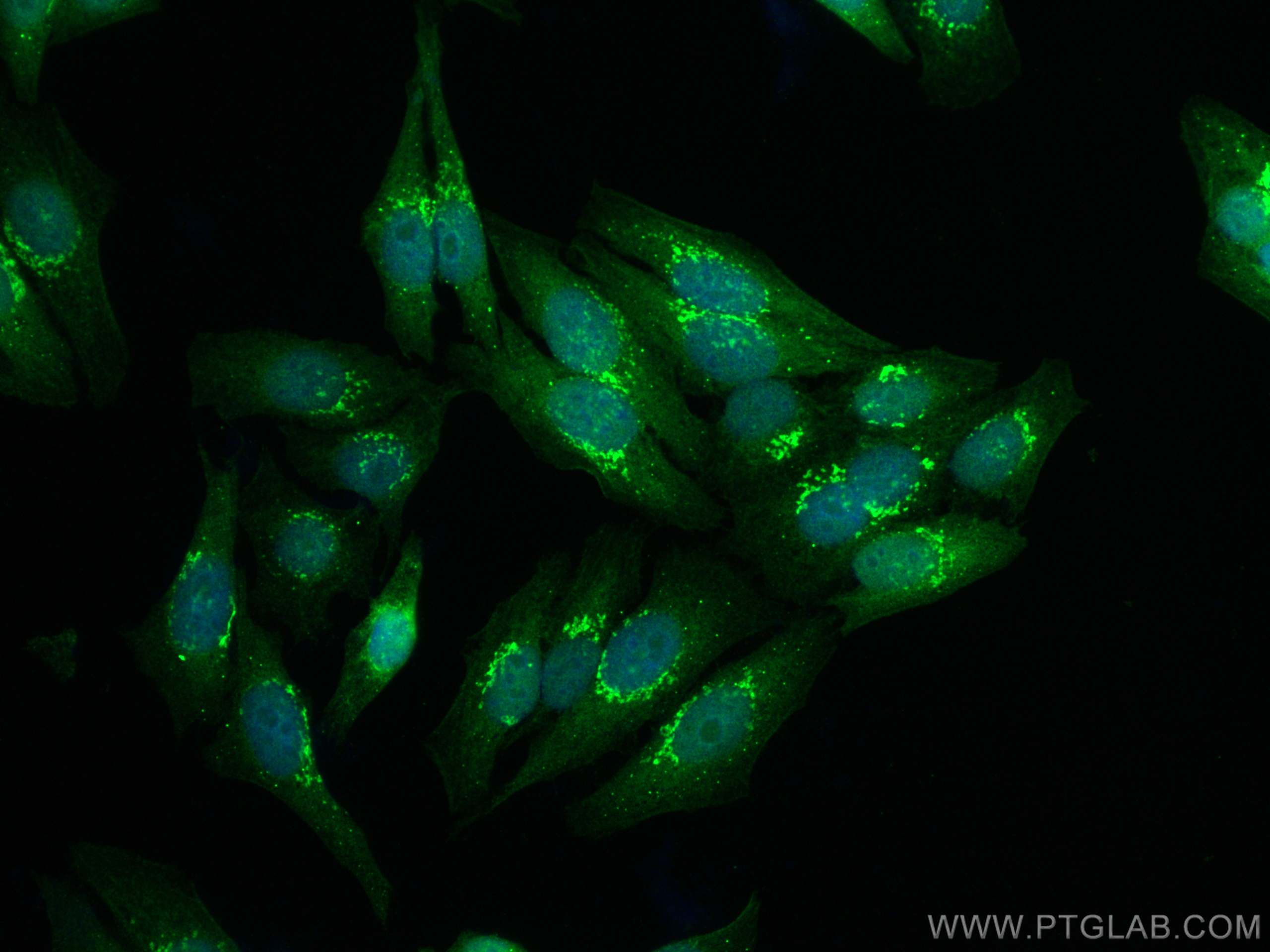- Phare
- Validé par KD/KO
Anticorps Polyclonal de lapin anti-PSAT1
PSAT1 Polyclonal Antibody for WB, IHC, IF/ICC, IP, ELISA
Hôte / Isotype
Lapin / IgG
Réactivité testée
Humain, rat, souris
Applications
WB, IHC, IF/ICC, IP, ELISA
Conjugaison
Non conjugué
N° de cat : 20180-1-AP
Synonymes
Galerie de données de validation
Applications testées
| Résultats positifs en WB | cellules HeLa, cellules A549, cellules HEK-293, cellules K-562, tissu cérébral de rat, tissu cérébral de souris |
| Résultats positifs en IP | cellules HeLa, |
| Résultats positifs en IHC | tissu de cancer du poumon humain, tissu de cancer du sein humain il est suggéré de démasquer l'antigène avec un tampon de TE buffer pH 9.0; (*) À défaut, 'le démasquage de l'antigène peut être 'effectué avec un tampon citrate pH 6,0. |
| Résultats positifs en IF/ICC | cellules HepG2, |
Dilution recommandée
| Application | Dilution |
|---|---|
| Western Blot (WB) | WB : 1:1000-1:8000 |
| Immunoprécipitation (IP) | IP : 0.5-4.0 ug for 1.0-3.0 mg of total protein lysate |
| Immunohistochimie (IHC) | IHC : 1:50-1:500 |
| Immunofluorescence (IF)/ICC | IF/ICC : 1:200-1:800 |
| It is recommended that this reagent should be titrated in each testing system to obtain optimal results. | |
| Sample-dependent, check data in validation data gallery | |
Applications publiées
| WB | See 7 publications below |
| IHC | See 1 publications below |
Informations sur le produit
20180-1-AP cible PSAT1 dans les applications de WB, IHC, IF/ICC, IP, ELISA et montre une réactivité avec des échantillons Humain, rat, souris
| Réactivité | Humain, rat, souris |
| Réactivité citée | Humain, souris |
| Hôte / Isotype | Lapin / IgG |
| Clonalité | Polyclonal |
| Type | Anticorps |
| Immunogène | PSAT1 Protéine recombinante Ag14044 |
| Nom complet | phosphoserine aminotransferase 1 |
| Masse moléculaire calculée | 370 aa, 40 kDa |
| Poids moléculaire observé | 37-40 kDa |
| Numéro d’acquisition GenBank | BC001618 |
| Symbole du gène | PSAT1 |
| Identification du gène (NCBI) | 29968 |
| Conjugaison | Non conjugué |
| Forme | Liquide |
| Méthode de purification | Purification par affinité contre l'antigène |
| Tampon de stockage | PBS with 0.02% sodium azide and 50% glycerol |
| Conditions de stockage | Stocker à -20°C. Stable pendant un an après l'expédition. L'aliquotage n'est pas nécessaire pour le stockage à -20oC Les 20ul contiennent 0,1% de BSA. |
Informations générales
PSAT1, also named as PSA and PSAT, belongs to the class-V pyridoxal-phosphate-dependent aminotransferase family and SerC subfamily. It catalyzes the reversible conversion of 3-phosphohydroxypyruvate to phosphoserine and of 3-hydroxy-2-oxo-4-phosphonooxybutanoate to phosphohydroxythreonine. PSAT1 represents a new interesting target for CRC therapy. (PMID:18221502) It may be implicated in altered serine metabolism and schizophrenia spectrum conditions. (PMID:20955740 )
Protocole
| Product Specific Protocols | |
|---|---|
| WB protocol for PSAT1 antibody 20180-1-AP | Download protocol |
| IHC protocol for PSAT1 antibody 20180-1-AP | Download protocol |
| IF protocol for PSAT1 antibody 20180-1-AP | Download protocol |
| IP protocol for PSAT1 antibody 20180-1-AP | Download protocol |
| Standard Protocols | |
|---|---|
| Click here to view our Standard Protocols |
Publications
| Species | Application | Title |
|---|---|---|
Science mTORC1 induces purine synthesis through control of the mitochondrial tetrahydrofolate cycle. | ||
EMBO Mol Med Macrophages induce malignant traits in mammary epithelium via IKKε/TBK1 kinases and the serine biosynthesis pathway. | ||
Proc Natl Acad Sci U S A Interleukin-6 mediates PSAT1 expression and serine metabolism in TSC2-deficient cells. | ||
EMBO Rep The breast cancer oncogene IKKε coordinates mitochondrial function and serine metabolism. | ||
Elife The mTORC1-mediated activation of ATF4 promotes protein and glutathione synthesis downstream of growth signals. | ||
Mol Metab Hepatic mTORC1 signaling activates ATF4 as part of its metabolic response to feeding and insulin. |
